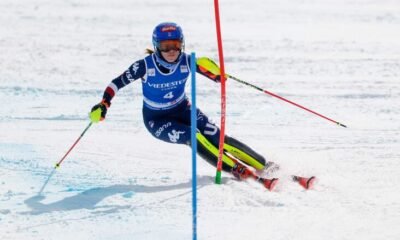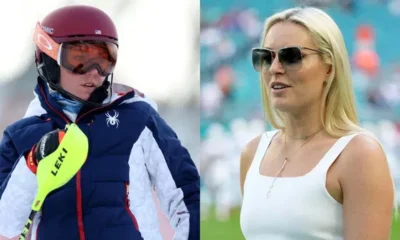Blog
Mikaela Shiffrin’s tentative schedule for the 2025–2026 Olympic Games.
Introduction
Mikaela Shiffrin, the most decorated American alpine skier of all time, heads into the 2025–2026 competition season with her sights firmly set on Milan–Cortina 2026. Since bursting onto the World Cup circuit as a teenager, Shiffrin has redefined technical skiing—amassing multiple World Championship titles and Olympic medals. With the next Winter Games scheduled from 6 to 22 February 2026, she will have the chance to showcase her talent across five alpine skiing disciplines: downhill, super-G, giant slalom, slalom, and the team combined event. This article provides a comprehensive, event-by-event look at Shiffrin’s tentative Olympic schedule, situating it within the broader logistical and competitive context of the 2026 Games.
The Venue and Broader Context
Unlike the compact footprint of most recent Winter Olympics, Milan–Cortina 2026 will be uniquely dispersed across northern Italy. Alpine skiing will be split between two iconic venues: Stelvio Ski Center in Bormio for the men’s events, and Tofane Alpine Skiing Centre in Cortina d’Ampezzo for the women’s events . The Games’ organizers have intentionally leveraged existing facilities spread over Lombardy, Veneto, the Valtellina and Fiemme valleys, and Milan. While this approach aligns with the International Olympic Committee’s sustainability push—minimizing new construction and environmental impact—it also introduces unprecedented logistical challenges, including travel times of up to 12 hours between venues and the absence of a single Olympic Village .
For athletes like Shiffrin, who may compete in multiple disciplines distributed across different sites, careful planning of training runs, rest periods, and transportation will be crucial. The women’s alpine events run from Sunday, 8 February (women’s downhill) through Wednesday, 18 February (women’s slalom), bookending a tightly packed schedule that leaves little margin for error .
Shiffrin’s 2026 Alpine Skiing Lineup
Based on historical participation patterns and her status as a premier all-around skier, Shiffrin’s program will likely include:
- Women’s Downhill – Speed discipline, February 8, 2026
- Women’s Team Combined – Two-person team event combining downhill and slalom, February 10, 2026
- Women’s Super-G – Speed discipline with technical turns, February 12, 2026
- Women’s Giant Slalom – Technical discipline emphasizing sweeping turns, February 15, 2026
- Women’s Slalom – Fast, technical discipline focusing on agility, February 18, 2026
This quintet of events represents a grueling two-week odyssey, challenging Shiffrin’s legendary blend of technical precision and mental resilience.
Event-by-Event Breakdown
1. Women’s Downhill (Sunday, 8 February 2026)
- Time: 5:30 a.m. (local)
- Venue: Tofane Alpine Skiing Centre, Cortina d’Ampezzo
- Format: One timed run down a long, high-speed course.
The downhill kicks off the women’s alpine program, demanding raw courage and fearless commitment. Shiffrin, more commonly celebrated for her technical prowess in slalom and giant slalom, has been steadily improving in speed events. A top-10 World Cup finish in downhill during the 2024–2025 season demonstrates her versatility. Weather and snow conditions will be critical, as high winds and changing surface texture can alter the run’s character. Given the early start time, Shiffrin and her team will need to adapt their warm-up protocol to Cortina’s chill morning air .
2. Women’s Team Combined (Tuesday, 10 February 2026)
- Times: 4:30 a.m. (downhill leg), 8:00 a.m. (slalom leg)
- Venue: Tofane Alpine Skiing Centre, Cortina d’Ampezzo
- Format: Mixed-gender teams of two athletes each; one downhill run and one slalom run per team.
Alpine combined debuted in a two-person team format for 2026 to bolster participation and spectacle. Shiffrin will pair with a male U.S. teammate—likely a specialist in either speed or technical skiing. This event tests adaptability: athletes must swiftly transition from the aerodynamics and nerve-racking speeds of downhill to the rapid-fire gate combinations of slalom. Team strategy—deciding run order and pacing—will be paramount. The tight turnaround between runs places additional physical and mental demands on Shiffrin, who excels at rapid reset under pressure .
3. Women’s Super-G (Thursday, 12 February 2026)
- Time: 5:30 a.m. (local)
- Venue: Tofane Alpine Skiing Centre, Cortina d’Ampezzo
- Format: One run combining speed and set-course technical turns.
Super-G (super giant slalom) sits between downhill and giant slalom in both course speed and turn radius. It requires skiers to memorize gate sequences on the fly during the course inspection—there are no practice runs. Shiffrin’s combination of analytical course study and explosive strength makes her a perennial podium contender. In recent World Cup seasons, she has secured multiple top-five super-G finishes, illustrating her readiness for Olympic gold in this discipline. Effective visualization during the pre-race inspection and precise edge control at high velocities will be keys to success .
4. Women’s Giant Slalom (Sunday, 15 February 2026)
- Times: 4:00 a.m. (first run), 7:30 a.m. (second run)
- Venue: Tofane Alpine Skiing Centre, Cortina d’Ampezzo
- Format: Two runs down different courses on the same slope; combined time decides medalists.
Giant slalom plays to Shiffrin’s historical strengths. With six World Cup GS titles in the 2024–2025 season, she remains the benchmark in GS technique. Consistency across both runs—the ability to combine a blistering first run with a controlled, polished second—is essential. Cortina’s course, with steep sections interspersed with broad turns, rewards skiers who can maintain line precision while absorbing terrain transitions. Her rhythmic turn initiation and metronomic carving technique will be asset, especially under variable light conditions in the dawn-to-morning timeframe .
5. Women’s Slalom (Wednesday, 18 February 2026)
- Times: 4:00 a.m. (first run), 7:30 a.m. (second run)
- Venue: Tofane Alpine Skiing Centre, Cortina d’Ampezzo
- Format: Two runs through tightly spaced gates requiring rapid edge changes; combined time counts.
Concluding the alpine skiing schedule, slalom is Shiffrin’s signature event. With four Olympic slalom medals (including gold in Sochi 2014 and PyeongChang 2018), she arrives as the overwhelming favorite. Tiny mistakes—any skid or stub toe—can cost tenths of a second and a place on the podium. Slalom courses often deteriorate quickly, creating ruts and unpredictable snow surfaces. Shiffrin’s famed adaptability and split-second reaction time will be critical to navigating Cortina’s primary slalom pitch. Her pre-run mental routine, involving deep focus exercises and breath control, will help her maintain composure in this high-pressure finale .
Strategies and Strengths
Shiffrin’s schedule demands seamless transitions between speed and technical disciplines. Her training regimen for 2025–2026 has incorporated specialized gym work for explosive leg power—vital for downhill and super-G—as well as agility drills and rapid gate simulation for slalom and giant slalom. By periodizing her training cycle to peak during the Olympic fortnight, she aims to optimize both anaerobic capacity (for short, intense GS and slalom runs) and aerobic resilience (for longer speed events) .
Her mental approach, crafted with longtime sports psychologist Dr. Bob Winters, emphasizes present-moment awareness, enabling her to compartmentalize each event regardless of past outcomes. After a comeback season marked by knee surgeries and COVID-19 disruptions, Shiffrin’s psychological fortitude has arguably never been stronger. The ability to “let go” of prior mistakes and execute each run with zero-error intent will be her hallmark.
Training and Preparation Timeline
- Summer 2025: Dryland training, strength conditioning, and on-snow camps in the U.S. Rockies.
- Autumn 2025: European glacier camps (Zermatt, Hintertux), focusing on speed-event line memorization and equipment fine-tuning.
- Late 2025: Technical gate work in Chilean Andes (Catedral de Bariloche) to acclimate to inverted turnaround cycles.
- January 2026: Pre-Olympic World Cup stop in Altenmarkt-Zauchensee (downhill, super-G) and Kronplatz (GS, slalom) as final tune-ups.
- Early February 2026: Arrival in Cortina d’Ampezzo for course inspections, free training runs, and Olympic test events.
By strategically scheduling her World Cup appearances, Shiffrin will aim to enter Milan–Cortina at optimal health—minimizing injury risk while fine-tuning race sharpness.
Logistical and Environmental Challenges
Milan–Cortina’s geographically dispersed design may force Shiffrin’s team to coordinate complex travel plans. Although all her races occur in Cortina, support staff and equipment may be split between other events in neighboring valleys, necessitating meticulous transport logistics. Given Italy’s unpredictable alpine weather, contingency plans for course delays or course swaps will be essential. Athletes will rely on real-time meteorological data and liaison officers to navigate sudden changes in wind, temperature, or snowfall, which can significantly alter course safety and fairness .
Environmental groups have also raised concerns about snowmaking requirements at Tofane, potentially affecting course consistency. Shiffrin’s race team will need to adapt ski waxing protocols to dynamic snow chemistry, a task aided by advanced Friction Reduction Testing and on-site lab analyses.
Conclusion
Mikaela Shiffrin’s tentative schedule at the Milan–Cortina 2026 Winter Olympics outlines a formidable challenge: five distinct alpine skiing events compressed into a ten-day window, demanding the full spectrum of her athletic skillset. From the speed-fueled roar of downhill on 8 February to the technical ballet of slalom on 18 February, she must navigate physical, mental, and logistical hurdles. Yet, it is precisely this breadth of competition that underscores Shiffrin’s pursuit of Olympic history—potentially joining the ranks of few athletes to medal in all five alpine disciplines. With meticulous preparation, an unwavering mental routine, and unparalleled technical prowess, she stands poised to leave an indelible mark on the 2026 Games. The mountains of Cortina await, and with them, the chance for Shiffrin to etch her name even deeper into winter sports legend.
-

 Blog3 weeks ago
Blog3 weeks agoPat Kelsey sends a strong three-word fiery message to the Louisville basketball’s team after their Cardinals 14th win…
-

 Blog3 weeks ago
Blog3 weeks agoMikaela Shiffrin responds to cross-country skier Jessie Diggins’ letter following her failure to secure a solitary podium finish at the FIS Nordic Worlds
-

 Blog3 months ago
Blog3 months agoNetflix releases “The Underdog,” a much-anticipated documentary about Drew Brees. slated for publication on the 25th
-

 Blog2 months ago
Blog2 months agoBehind the Turns: Netflix’s Upcoming Documentary on Mikaela Shiffrin’s Fights, Fears, and Love
-

 Blog3 weeks ago
Blog3 weeks agoWomen’s Slalom Run 1 at the FIS Alpine Skiing World Cup: Are
-

 Blog3 months ago
Blog3 months agoFederica Brignone: “I’m fine, but my return to skiing is far off.”
-

 Blog2 months ago
Blog2 months agoAlice Cooper: From Fragile Boy to Shock Rock Icon—Netflix Unmasks the Nightmare
-

 Blog3 weeks ago
Blog3 weeks agoMikaela Shiffrin sends a two-word message to Lindsey Vonn as she became the oldest woman on the skiing podium
